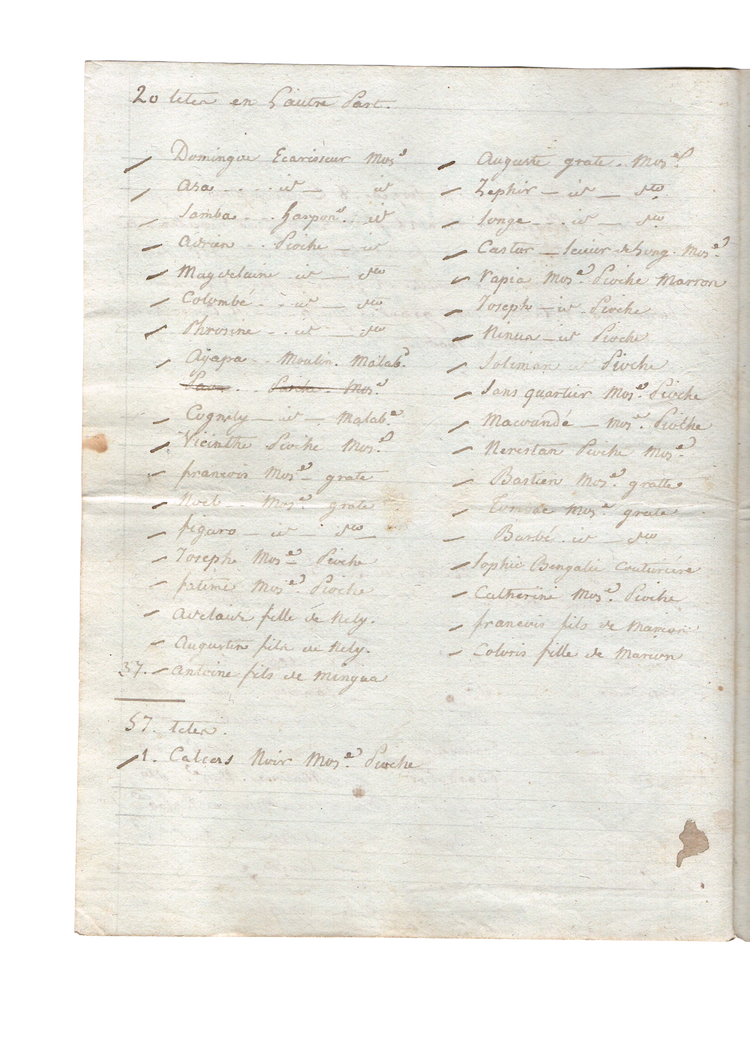A complete cotton plantation inventory, with 175 enslaved individuals, likely from the Seychelles
- Regular price
- €4.500,00 EUR
- Regular price
-
- Sale price
- €4.500,00 EUR
- Unit price
- per
Inventory of a cotton plantation.
[Réunion, Mauritius, or the Seychelles, ca. 1780-1820].
4° (24.3 × 18.4 cm), 6 pp. Manuscript in ink in French.
Unbound.
A detailed manuscript inventory of a large cotton estate in the French Indian Ocean world, remarkable for recording more than 175 enslaved individuals by name, origin, occupation, and often by family relationship. Compiled at the turn of the nineteenth century and divided into three lots, it provides an unusually complete portrait of the human and material structure of a plantation in this region.
The enslaved population, totaled in the manuscript as 60, 61, and 58 persons across the three lots, contains a wide range of origins: Malabar, Mozambique, Malagasy, Bengali, “Cafre” and Créole. They had a wide range of occupations: commandeurs, carpenters, sawyers, flayers, mill workers, gardeners, seamstresses, a baker, and many field hands (pioche). Women, children, and newborns appear throughout, alongside several individuals identified as marron, and numerous family units, indicating a community with established family structures and multiple generations present, rather than a workforce composed solely of recent arrivals.
The text further describes extensive acreages under cotton, maize, and sweet potatoes, together with houses, thatched or boarded storehouses, presses, and a full range of industrial and agricultural installations. Each division includes eight cotton mills with iron cylinders, maize mills, henhouses, pigeon houses, a considerable quantity of tools (hoes, axes, billhooks, cotton knives, marmites, iron fittings), and numerous pirogues, nets, harpoons, and fishing lines—clear evidence of a coastal or island setting. Livestock consists mainly of poultry, ducks, and sows.
The combination of cotton as the principal crop, the reliance on pirogues and fishing gear, and the ethnic composition of the enslaved population point clearly toward the Mascarene and Seychelles plantation sphere, most plausibly Île Bourbon (Réunion), Île de France (Mauritius), or the Seychelles. The paper bears a “B. Dumas” watermark, characteristic of late-eighteenth and early-nineteenth-century French handmade paper widely exported to the Mascarene Islands and other French Indian Ocean colonies.
The attribution remains speculative, but the characteristics of the estate strongly resemble those of late-eighteenth-century cotton plantations in the Seychelles, particularly on Mahé. Possibly Anse Royale, Anse aux Pins, and Pointe au Sel. As one of the few surviving records to document more than 175 enslaved individuals in such detail, it also constitutes a crucial source for genealogical and heritage research in the Indian Ocean.
Condition: ink lightly faded but fully legible, a few small stains. Otherwise in very good condition.
Couldn't load pickup availability
Share






Contact
Email: hugo@artemrarebooks.com
Phone: +31651042297
Visit us on appointment at:
Former US Embassy
Lange Voorhout 102
2514EJ
The Hague (The Netherlands)
Shipping address:
Nannie van Wehlstraat 51
2548MN
The Hague
The Netherlands






